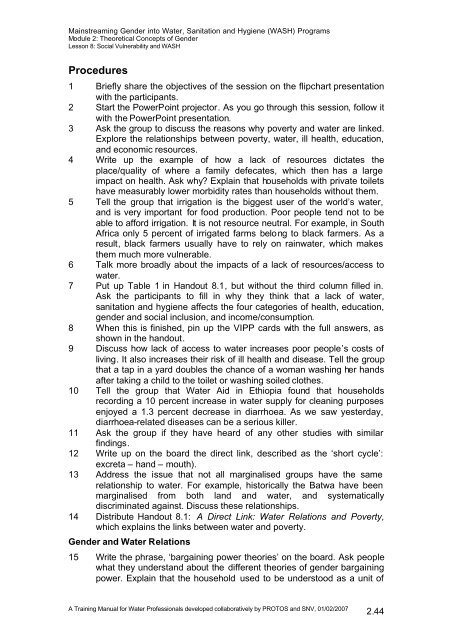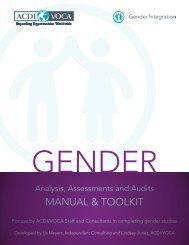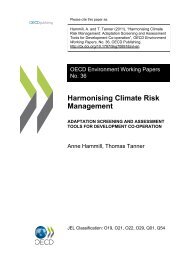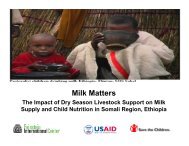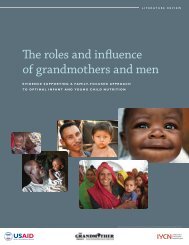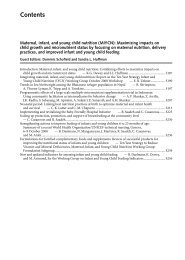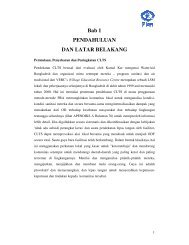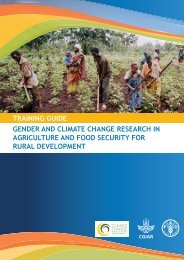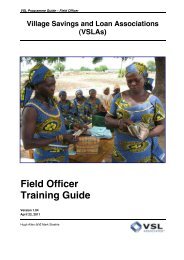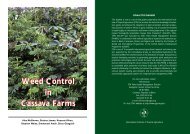Module 2. Theorethical Concepts of Gender - FSN Network Portal
Module 2. Theorethical Concepts of Gender - FSN Network Portal
Module 2. Theorethical Concepts of Gender - FSN Network Portal
Create successful ePaper yourself
Turn your PDF publications into a flip-book with our unique Google optimized e-Paper software.
Mainstreaming <strong>Gender</strong> into Water, Sanitation and Hygiene (WASH) Programs<br />
<strong>Module</strong> 2: Theoretical <strong>Concepts</strong> <strong>of</strong> <strong>Gender</strong><br />
Lesson 8: Social Vulnerability and WASH<br />
Procedures<br />
1 Briefly share the objectives <strong>of</strong> the session on the flipchart presentation<br />
with the participants.<br />
2 Start the PowerPoint projector. As you go through this session, follow it<br />
with the PowerPoint presentation.<br />
3 Ask the group to discuss the reasons why poverty and water are linked.<br />
Explore the relationships between poverty, water, ill health, education,<br />
and economic resources.<br />
4 Write up the example <strong>of</strong> how a lack <strong>of</strong> resources dictates the<br />
place/quality <strong>of</strong> where a family defecates, which then has a large<br />
impact on health. Ask why? Explain that households with private toilets<br />
have measurably lower morbidity rates than households without them.<br />
5 Tell the group that irrigation is the biggest user <strong>of</strong> the world’s water,<br />
and is very important for food production. Poor people tend not to be<br />
able to afford irrigation. It is not resource neutral. For example, in South<br />
Africa only 5 percent <strong>of</strong> irrigated farms belong to black farmers. As a<br />
result, black farmers usually have to rely on rainwater, which makes<br />
them much more vulnerable.<br />
6 Talk more broadly about the impacts <strong>of</strong> a lack <strong>of</strong> resources/access to<br />
water.<br />
7 Put up Table 1 in Handout 8.1, but without the third column filled in.<br />
Ask the participants to fill in why they think that a lack <strong>of</strong> water,<br />
sanitation and hygiene affects the four categories <strong>of</strong> health, education,<br />
gender and social inclusion, and income/consumption.<br />
8 When this is finished, pin up the VIPP cards with the full answers, as<br />
shown in the handout.<br />
9 Discuss how lack <strong>of</strong> access to water increases poor people’s costs <strong>of</strong><br />
living. It also increases their risk <strong>of</strong> ill health and disease. Tell the group<br />
that a tap in a yard doubles the chance <strong>of</strong> a woman washing her hands<br />
after taking a child to the toilet or washing soiled clothes.<br />
10 Tell the group that Water Aid in Ethiopia found that households<br />
recording a 10 percent increase in water supply for cleaning purposes<br />
enjoyed a 1.3 percent decrease in diarrhoea. As we saw yesterday,<br />
diarrhoea-related diseases can be a serious killer.<br />
11 Ask the group if they have heard <strong>of</strong> any other studies with similar<br />
findings.<br />
12 Write up on the board the direct link, described as the ‘short cycle’:<br />
excreta – hand – mouth).<br />
13 Address the issue that not all marginalised groups have the same<br />
relationship to water. For example, historically the Batwa have been<br />
marginalised from both land and water, and systematically<br />
discriminated against. Discuss these relationships.<br />
14 Distribute Handout 8.1: A Direct Link: Water Relations and Poverty,<br />
which explains the links between water and poverty.<br />
<strong>Gender</strong> and Water Relations<br />
15 Write the phrase, ‘bargaining power theories’ on the board. Ask people<br />
what they understand about the different theories <strong>of</strong> gender bargaining<br />
power. Explain that the household used to be understood as a unit <strong>of</strong><br />
A Training Manual for Water Pr<strong>of</strong>essionals developed collaboratively by PROTOS and SNV, 01/02/2007<br />
<strong>2.</strong>44


